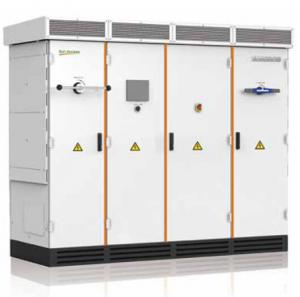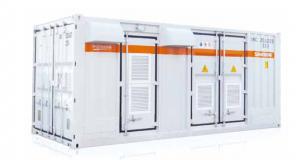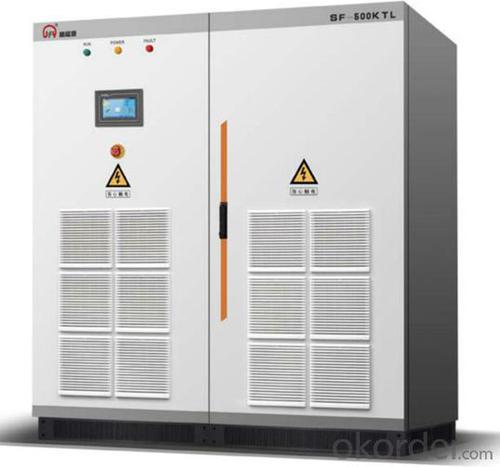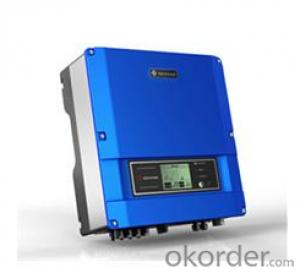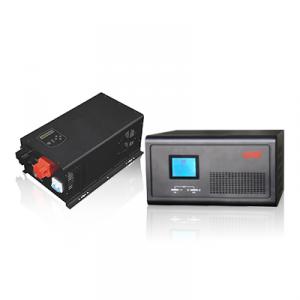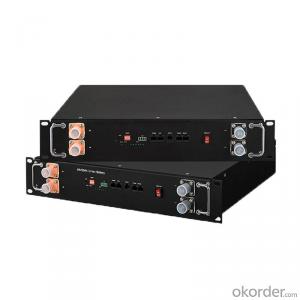500KW Solar Inverter For Solar Power Plant or Solar Power System without Transformer
- Loading Port:
- China main port
- Payment Terms:
- TT or LC
- Min Order Qty:
- 10 unit
- Supply Capability:
- 1000 unit/month
OKorder Service Pledge
OKorder Financial Service
You Might Also Like
1. Structure of 500KW Solar Inverter for Solar Power Plant or Solar Power System without Transformer Description
A solar inverter, or PV inverter, or Solar converter, converts the variable direct current (DC) output of a photovoltaic (PV) solar panel into a
utility frequency alternating current (AC) that can be fed into a commercial electrical grid or used by a local, off-grid electrical network. It is
a critical BOS–component in a photovoltaic system, allowing the use of ordinary AC-powered equipment. Solar inverters have special
functions adapted for use with photovoltaic arrays, including maximum power point tracking and anti-islanding protection.
2. Main Features of 500KW Solar Inverter for Solar Power Plant or Solar Power System without Transformer
• With the advanced system intelligence, highly speed MPPT technology, industrial-grade engineeringand compete fault
protections,Sunforest series central commercial inerters maximize system uptime and power production, even in harshest
environments
• DSP-controlled IGBT circuitry to achieve high efficiency, reliability and low installing cost.
• Sunforest KT series grid-tied inverters are integrated with an isolatin transformer
• Multiple work mode, SVG(Static Var Generator) mode, Anti-Reverse power control mode
Utility-read features
• Open communication protocol, good compatible with any third-party monitoring system and easily integrated into SCADA
systems
• Remote control of real and reactive power
• LVRT(Low voltage ride through)
• Power factor control
• Simplified grid interconnection
Optimal MPPT technology
• Rapid and accurate control boost PV plant KWH yield
• Provides a wide range of operation voltage
3. 500KW Solar Inverter for Solar Power Plant or Solar Power System without Transformer Images
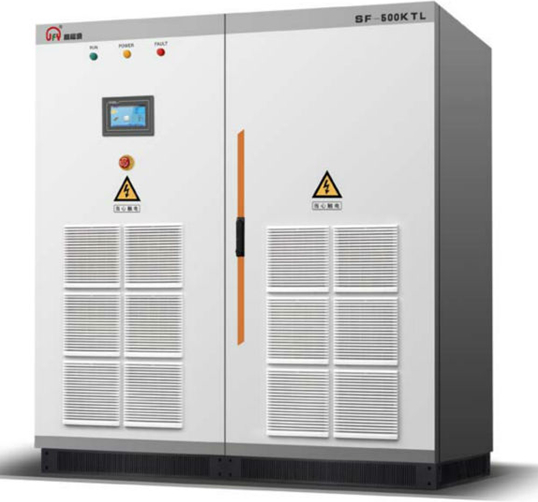

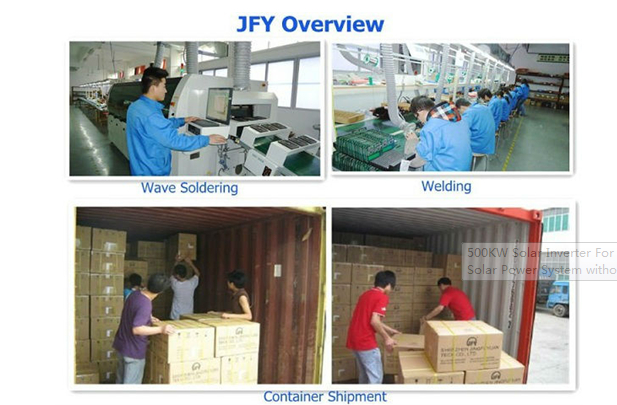
4. 500KW Solar Inverter for Solar Power Plant or Solar Power System without Transformer Specification
Max. DC Input Power | 285KW | 570KW | 715KW |
Max DC Voltage | 1000Vdc | ||
MPPT Operating Range | 450~820Vdc | ||
Number of Parallel Inputs | 5 | 12 | |
Number of MPP Trackers | 1 | ||
Max. Input Current | 600A | 1200A | 1400A |
Nominal Output Power | 250KW | 500KW | 630KW |
Max. Output Power | 275KW | 550KW | 693KW |
Nominal Output Current | 535A | 1070A | 1155A |
Max. Output Current | 589A | 1177A | 1270A |
Nominal AC Output Voltage | 270Vac | 270Vac | 315Vac |
AC Output Voltage Range | 243~297Vac | 283~347Vac | |
AC Grid Frequency Range | 50Hz | ||
Power Factor (cosφ) | 0.9(leading)~0.9(lagging) | ||
THDI | <3% | ||
Max.efficiency | 98.40% | 98.50% | 98.60% |
Euro.efficiency | 98.00% | 98.00% | 98.20% |
MPPT. efficiency | 99.90% | 99.90% | 99.90% |
Operating Temperature | -25°C~+60°C(derated power above50°C) | ||
Altitude | 6000m(derated power above 3000m) | ||
Noise (typical) | <65dB(A) | ||
Operating Consumption | <100W | ||
Electrical Isolation | Transformerless | ||
Cooling Concept | Fan Cooling | ||
Protect Level | IP20 | ||
Communication | RS485 | ||
Dimension (W×D×H)(mm) | 1000*900*1850 | 1700*900*1850 | 1700*900*1850 |
Weight (Kg) | 890 | 1427 | 1677 |
5. FAQ of 500KW Solar Inverter for Solar Power Plant or Solar Power System without Transformer
Q1:Can we visit your factory?
A1:Sure,welcome at any time,seeing is believing.
Q2:Which payment terms can you accept?
A2:T/T,L/C,Moneygram,Paypal are available for us.
- Q:Can a solar inverter be used with different types of mounting systems?
- Yes, a solar inverter can be used with different types of mounting systems. The solar inverter is responsible for converting the direct current (DC) generated by the solar panels into alternating current (AC) that can be used to power electrical devices. It is compatible with various mounting systems such as rooftop, ground-mounted, or pole-mounted installations, as long as the solar panels are properly connected to the inverter.
- Q:Can a solar inverter be installed in a residential area?
- Yes, a solar inverter can be installed in a residential area. In fact, residential areas are common locations for solar installations, including the installation of solar inverters. These inverters are responsible for converting the direct current (DC) electricity generated by solar panels into alternating current (AC) electricity that can be used by household appliances and fed back into the electrical grid. Installing a solar inverter in a residential area allows homeowners to harness the power of solar energy and reduce their reliance on traditional electricity sources.
- Q:How does the quality of the AC waveform affect the performance of a solar inverter?
- The quality of the AC waveform directly affects the performance of a solar inverter. A clean and stable waveform is essential for efficient and reliable operation of the inverter. Any deviations, distortions, or harmonics in the waveform can lead to increased power losses, reduced conversion efficiency, and potential damage to the inverter. Therefore, a high-quality AC waveform is crucial for optimal performance and maximum power output from a solar inverter.
- Q:Can a solar inverter be used with batteries?
- Yes, a solar inverter can be used with batteries. In fact, using a solar inverter with batteries is a common practice in solar energy systems. The inverter helps convert the direct current (DC) electricity generated by the solar panels into alternating current (AC) electricity that can be used to power various appliances and devices. When batteries are connected to the system, the excess electricity generated by the solar panels can be stored in the batteries for later use, allowing for continuous power supply even when the sun is not shining.
- Q:Can a solar inverter be integrated with a smart home system?
- Yes, a solar inverter can be integrated with a smart home system. This integration allows for monitoring and controlling the solar energy production, as well as optimizing energy usage and managing the overall efficiency of the system.
- Q:Can a solar inverter be used in areas with high dust and dirt accumulation?
- Yes, a solar inverter can be used in areas with high dust and dirt accumulation. However, it is important to regularly clean and maintain the inverter to prevent any performance issues caused by the accumulation of dust and dirt.
- Q:What are the installation requirements for a solar inverter?
- The installation requirements for a solar inverter typically include a suitable mounting location, proper ventilation, and a stable electrical connection. The inverter should be installed in a shaded area, away from direct sunlight and extreme temperatures. It should be mounted securely on a sturdy surface, such as a wall or a rack. Adequate ventilation is necessary to dissipate heat generated during operation. Additionally, the inverter must be connected to the electrical panel or grid with the appropriate wiring and circuit breakers, following local electrical codes and regulations.
- Q:Is it possible to monitor the performance of a solar inverter remotely?
- Yes, it is possible to monitor the performance of a solar inverter remotely. With the advancements in technology, solar inverters can be equipped with monitoring systems that allow users to monitor their performance, including energy production, efficiency, and any potential issues, through online platforms or mobile applications. Remote monitoring enables users to keep track of their solar energy system's performance and make informed decisions for maintenance or troubleshooting, even when they are not physically present at the installation site.
- Q:PV grid-connected inverter and independent inverter in the control of what is the difference
- PV grid-connected inverter in the grid before the inverter needs to determine the phase voltage phase frequency, the first phase-locked, in the grid and power generation.
- Q:What are the safety features in a solar inverter?
- Solar inverters, also known as photovoltaic (PV) inverters, play a crucial role in converting the direct current (DC) electricity generated by solar panels into alternating current (AC) electricity that can be used to power homes or businesses. In order to ensure the safe and efficient operation of solar inverters, they are equipped with various safety features. One of the primary safety features in a solar inverter is the ground fault protection. This feature is designed to detect any current leakage to the ground, which could indicate a fault in the system. If a ground fault is detected, the inverter will immediately shut down to prevent any potential electrocution hazards. To protect against overvoltage situations, solar inverters are equipped with surge protection devices (SPDs). These devices are responsible for diverting excessive voltage spikes or surges to the earth, thereby protecting the inverter and other connected electrical equipment from damage. In the event of a grid power outage or blackout, solar inverters are equipped with anti-islanding protection. This feature ensures that the inverter automatically disconnects from the grid, preventing any power backfeeding, which could pose a serious threat to utility workers trying to repair the grid. Temperature monitoring is another crucial safety feature in solar inverters. Since inverters can generate heat during operation, they are equipped with temperature sensors to monitor the internal temperature. If the temperature exceeds the safe limit, the inverter will automatically shut down to prevent any potential fire hazards. Furthermore, solar inverters are often equipped with built-in arc fault circuit interrupters (AFCIs). These devices are designed to detect and interrupt dangerous arc faults that can occur due to damaged or deteriorating wiring connections. By quickly stopping the flow of electricity, AFCIs help to prevent electrical fires. Lastly, many solar inverters have advanced monitoring and diagnostic systems. These systems provide real-time data and alerts, allowing users or installers to identify and address any potential safety issues promptly. Overall, the safety features in a solar inverter are crucial in ensuring the safe and reliable operation of the system. These features protect against electrical hazards, prevent damage to the inverter and connected equipment, and contribute to the overall safety of the solar power generation system.
1. Manufacturer Overview |
|
|---|---|
| Location | |
| Year Established | |
| Annual Output Value | |
| Main Markets | |
| Company Certifications | |
2. Manufacturer Certificates |
|
|---|---|
| a) Certification Name | |
| Range | |
| Reference | |
| Validity Period | |
3. Manufacturer Capability |
|
|---|---|
| a)Trade Capacity | |
| Nearest Port | |
| Export Percentage | |
| No.of Employees in Trade Department | |
| Language Spoken: | |
| b)Factory Information | |
| Factory Size: | |
| No. of Production Lines | |
| Contract Manufacturing | |
| Product Price Range | |
Send your message to us
500KW Solar Inverter For Solar Power Plant or Solar Power System without Transformer
- Loading Port:
- China main port
- Payment Terms:
- TT or LC
- Min Order Qty:
- 10 unit
- Supply Capability:
- 1000 unit/month
Offcanvas right
OKorder Service Pledge
OKorder Financial Service
Similar products
New products
Hot products
Hot Searches
Related keywords

